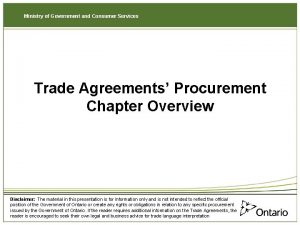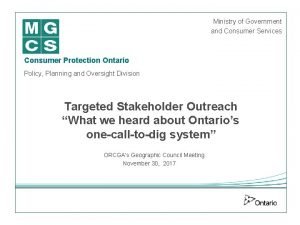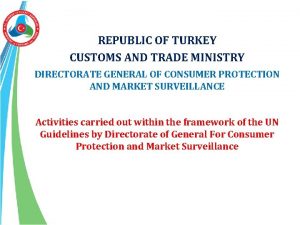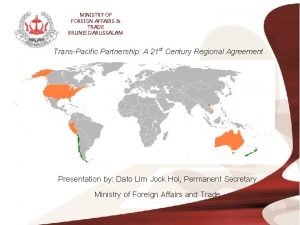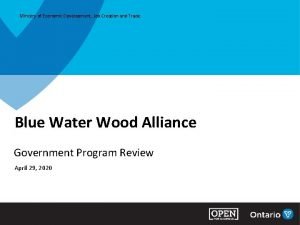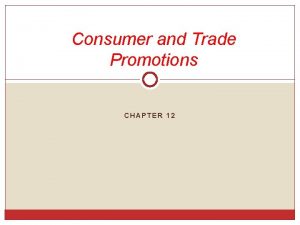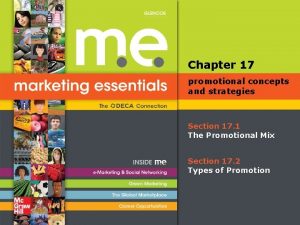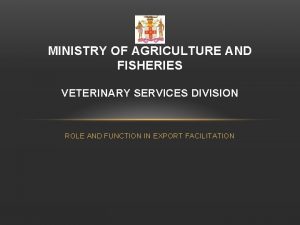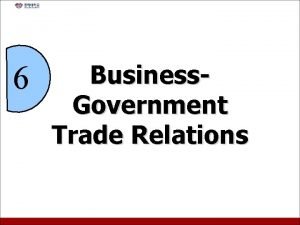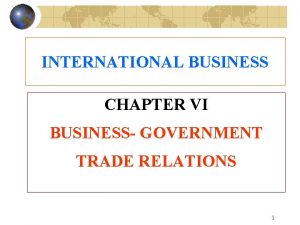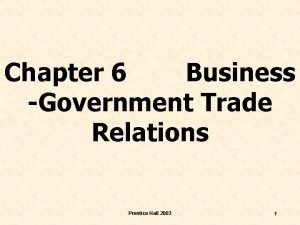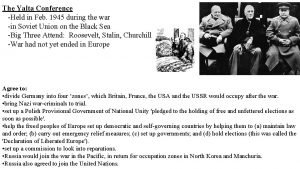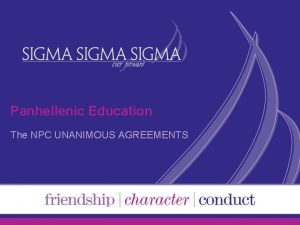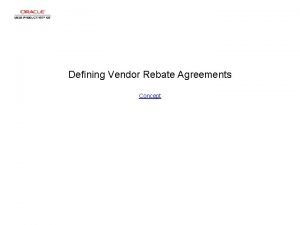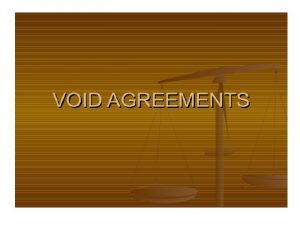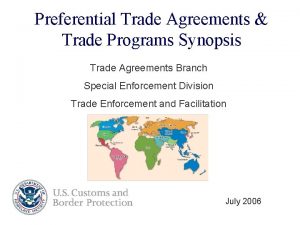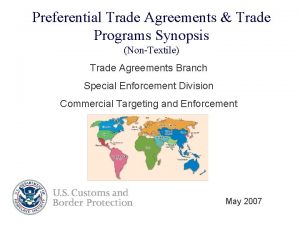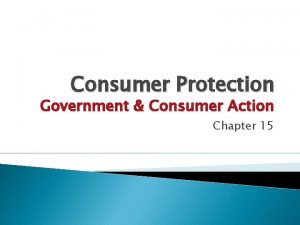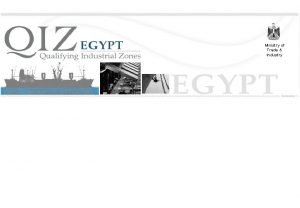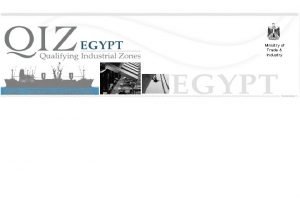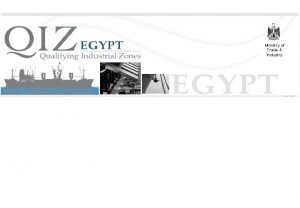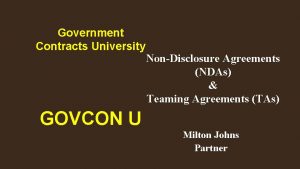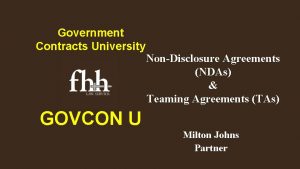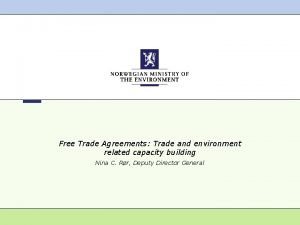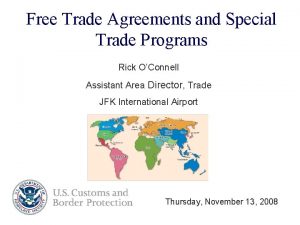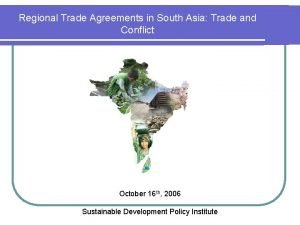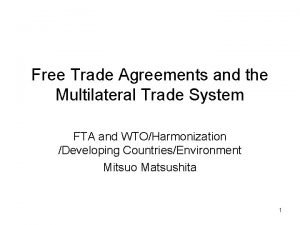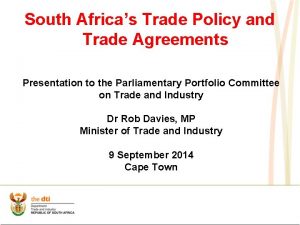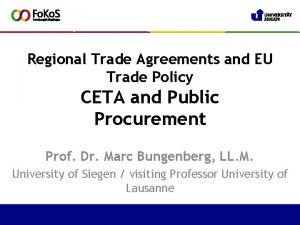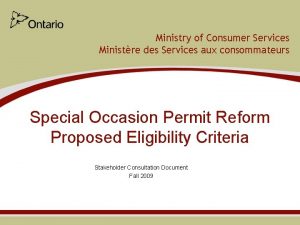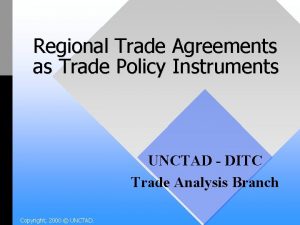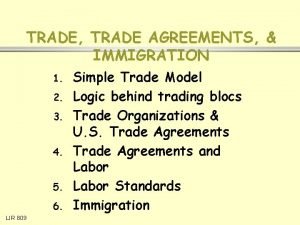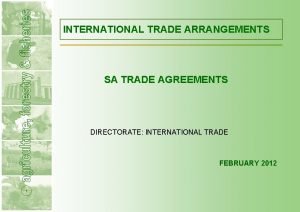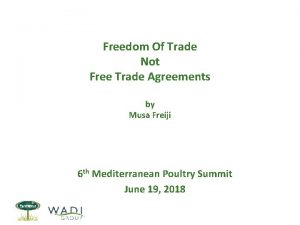Ministry of Government and Consumer Services Trade Agreements







































- Slides: 39

Ministry of Government and Consumer Services Trade Agreements’ Procurement Chapter Overview Disclaimer: The material in this presentation is for information only and is not intended to reflect the official position of the Government of Ontario or create any rights or obligations in relation to any specific procurement issued by the Government of Ontario. If the reader requires additional information on the Trade Agreements, the reader is encouraged to seek their own legal and business advice for trade language interpretation

Ontario Government Trade Agreements Procurement Chapter Overview 1. Setting Context Around Procurement 2. What trade agreements affect my organization? 3. Why do we need trade agreements? 4. Who are covered by these trade agreements? 5. What are the procurement commitments in these trade agreements? 6. Questions and Answers

1. Setting Context Around Procurement

Setting Context Around Procurement Ontario is committed to ensuring that procurement in the public sector is open, fair and transparent. There are several areas that support achieving this objective: Responsible Management Value for Money Vendor Access, Transparency and Fairness Quality Service Delivery Upholding Ontario’s Trade Agreements 3

2. What trade agreements affect my organization?

Agreements that Affect Covered Entities Covered entities are required to comply with the requirements of the procurement chapter of the following trade agreements. These entities include ministries, certain agencies, municipalities and some organizations in the broader public sector (including school boards and publicly funded academic, health and social service entities) 1 2 3 The Current Agreement on Internal Trade (AIT) The Ontario Québec Trade and Cooperation Agreement (OQTCA) The Canada European Union (EU) Comprehensive Economic and Trade Agreement (CETA) – pending ratification 5

Agreements that Impact Covered Entities (continued 1) 1 The Current Agreement on Internal Trade (AIT) Effective Date Effective July 1, 1995 for all provinces, NWT, Yukon and the federal government Purpose To reduce and eliminate, to the extent possible, barriers to the free movement of persons, goods, services, and investment within Canada and to establish an open, efficient, and stable domestic market. Details Chapter Five specifically addresses the requirements and obligations of the parties to ensure that they conduct their procurements in a fair, transparent and non-discriminatory fashion. Current Status The current AIT is being re-negotiated and updated to ensure Canadian suppliers have equal or better guaranteed access to government procurements as European suppliers will under CETA. 6

Agreements that Impact Covered Entities, (continued 2) 2 The Revised Ontario Québec Trade and Cooperation Agreement (OQTCA) Effective Date Originally signed in 2009 and the revised agreement was signed September 11, 2015 Revised OQTCA took effect on January 1, 2016 for ministries and agencies and will take effect on September 1, 2016 for all other covered entities. Reporting and single point of access requirements will be effective at a later date. Purpose To promote further integration of the Ontario and Québec economies. Details Chapter Nine addresses government procurement. Current Status Government procurement rules have been updated to harmonize with those of CETA where possible, thereby streamlining requirements. 7

Agreements that Impact Covered Entities (continued 3) 3 The Canada EU Comprehensive Economic and Trade Agreement (CETA) Effective Date Expected to come into force one year after ratification. Purpose Provide expanded market access for Canadian suppliers to EU markets and EU suppliers gain expanded access to Canadian market. Details CETA includes access to government procurement markets. Current Status The text of the agreement is currently undergoing legal review, followed by translation and ratification. 8

3. Why do we need trade agreements?

Importance of Trade Agreements Trade agreements support the exchange of goods and services between Ontario and other countries and provinces. § Trade agreements typically eliminate or reduce tariff and other barriers to trade that prevent goods and services in one jurisdiction from being sold in another one. § Trade agreements can increase economic growth and provide access to other markets to increase our competiveness. § Trade agreements may be negotiated with other countries and between provinces in Canada. 10

What are the Principles of Trade Agreements? Trade agreements and procurement practices are built on the following fundamental principles: Fairness Transparency Reciprocal non discrimination 11

What are the Principles of Trade Agreements? , (continued 1) Fairness is reflected in the core obligations of transparency and equitable treatment of suppliers that requires parties to: – Provide treatment no less favourable to other parties’ suppliers, goods and services than that provided to domestic suppliers. Fairness – Adopt measures to reduce and eliminate barriers to the free movement of persons, goods, services and investments between parties. 12

What are the Principles of Trade Agreements? (continued 2) Transparency includes making information readily available to entities of other jurisdiction about: – Domestic laws, regulations, programs and administrative procedures. Transparency – Procurement opportunities through the use of an electronic tendering system, by advertising in print media or through the use of published source lists. 13

What are the Principles of Trade Agreements? (continued 3) Reciprocal non discrimination requires parties to maintain measures that do not discriminate against suppliers, goods and services of other parties. Reciprocal nondiscrimination – Geographic neutrality is contained in the reciprocal nondiscrimination principle: It requires parties and their covered entities to ensure access for suppliers of other parties to procurement opportunities regardless of their origin and physical location. 14

4. Who is covered by these trade agreements?

Entities Included in Trade Agreements Covered entities include ministries, certain agencies, municipalities and some organizations in the broader public sector (including school boards and publicly-funded academic, health and social service entities) 16

Entities included in trade agreements Entities Provincial ministries AIT OQTCA CETA X X X Provincial and classified agencies X* X 1 Provincial agencies of a commercial or industrial nature X X X Municipalities and their entities X X X Schoolboards, publiclyfunded academic, health, social service entities X X X Provincial and municipal ports, airports, water works Notes *Partial Coverage: only those listed in the agreement are covered. 1 OQTCA and CETA Exclusions: Infrastructure Ontario, Ontario Electricity Financial Corporation, Independent Electricity System Operator, Electrical Safety Authority, Office of the Legislative Assembly CETA Exclusion: Local energy entities 17

Procurements Covered by Each Trade Agreement Procurements included under Ontario’s trade agreements are distinguished by type and monetary value of the procurement. Procurement Type AIT OQTCA CETA Goods over threshold X X X Construction over threshold X X X Services* above threshold not specifically excluded (health, financial, social services, etc. ) X X X *Only services listed in the agreements are covered 18

Current AIT Thresholds Procurements included under Ontario’s trade agreements are distinguished by type and monetary value of the procurement. Procurement Type Current AIT Threshold Goods (ministries and certain agencies) $25, 000 Goods (municipalities, school boards and publicly-funded academic, health and social service entities) $100, 000 Services (ministries, certain agencies, municipalities, school boards and publicly-funded academic, health and social service entities) $100, 000 Construction (ministries and certain agencies) $100, 000 Construction (municipalities, school boards and publiclyfunded academic, health and social service entities) $250, 000 Goods and services by entity of industrial or commercial nature $500, 000 Construction by entity of industrial or commercial nature $5, 000 19

Revised OQTCA Thresholds Procurements included under Ontario’s trade agreements are distinguished by sector, type and monetary value of the procurement. Procurement Type Revised OQTCA Threshold Goods (ministries and certain agencies) $25, 000 Goods (municipalities, school boards and publiclyfunded academic, health and social service entities) $100, 000 Services (ministries, certain agencies, municipalities, school boards and publicly-funded academic, health and social service entities) $100, 000 Construction (ministries, certain agencies, municipalities, school boards and publicly-funded academic, health and social service entities) $100, 000 Goods and Services by an entity of industrial or commercial nature $500, 000 Construction by entity of industrial or commercial nature $5, 000 20

CETA Thresholds Procurements included under Ontario’s trade agreements are distinguished by type and monetary value of the procurement. Procurement Type CETA Threshold* Goods and services contracts $309, 100 Goods and services for utilities (transit, water, ports, airports) $548, 700 Construction services contracts $7, 700, 000 *CETA thresholds are expressed in an international monetary currency and converted to domestic currencies once every two years. 21

5. What are the procurement commitments in these trade agreements?

Procurement Commitments Covered entities are responsible for ensuring they are compliant with procurement related commitments in the trade agreements. Ontario’s trade procurement commitments include: 1. Information and Reporting – Adopting new rules, standards and procedures to ensure transparency of its procurements enabled through a Canada-wide single point of access (SPA). 2. Procurement Practices – Revised and/or expanded rules and procedures around evaluation criteria, debriefings and duration of bid postings. 3. Bid Dispute – Establishing a timely, impartial administrative procedure for suppliers to challenge a procurement process conducted by a covered entity. 23

Procurement Commitments (continued 1) 1. Information and Reporting Single Point of Access Requirements CETA and OQTCA require covered entities to post their procurement opportunities on a Canada wide Single Point of Access (SPA) within five years of the coming into force date of CETA. In the meantime, links to procurement opportunities should be posted on a website that is easily accessible to suppliers. Implication for Covered Entities All covered entities will be required to make their tender notices accessible through the Canada wide Single Point of Access, when it is available. 24

Procurement Commitments (continued 2) 1. Information and Reporting Requirements Covered entities will need to report annually on their procurement activities above the trade agreements’ applicable threshold. With expanded coverage of entities in the trade agreements (CETA and OQTCA), this means more entities will have to report. The annual report will need to include: Implication for Covered Entities Some covered entities already are required to report annually on their procurement activity under AIT or as directed in the Ontario Public Service (OPS) Procurement Directive. § The number and aggregate value of contracts awarded at or above the trade agreements’ applicable threshold. § The aggregate value of contract awarded will need to be broken down by each category of procurement (goods, services or construction). 25

Procurement Commitments (continued 3) 1. Information and Reporting Requirements, cont’d The annual report will need to include: § Where a single or sole procurement has been conducted, the trade agreement’s allowable exception that was used Implication for Covered Entities, cont’d Some entities, previously not required to report on procurement activities, will now be required to do so 26

Procurement Commitments (continued 4) 2. Procurement Practices Procurement rules and procedures have been expanded/revised in the following areas: § Evaluation Criteria – In addition to disclosing the evaluation method to be used in a procurement process, covered entities would also be required to provide all evaluation criteria. § Debriefings – covered entities will be required to inform all participating suppliers of its contract award decision and, upon request of the supplier, provide an unsuccessful supplier with the reasons why its tender was not selected. Implication for Covered Entities will need to review their procurement policies, systems, templates and supporting tools to ensure alignment with revised procurement rules. § A statement in the tender documentation that the procurement is subject to the procurement chapter of OQTCA and a statement that the procurement is subject to CETA. 27

Procurement Commitments (continued 5) 2. Procurement Practices Bid Posting Period and Contract Award Requirements § The duration of bid posting – When CETA comes into force, it will require entities to post procurement opportunities for open competitive procurement for no less than 40 days. § However, this posting time can be reduced if certain conditions are met such as, posting the tender document at the same time as the tender notice. Implication for Covered Entities will need to review their procurement policies, systems, templates and supporting tools to ensure alignment with revised procurement rules. § Contract award information must also be made available within 72 days of awarding a contract. 28

Procurement Commitments (continued 6) 3. Bid Dispute Both CETA and OQTCA require covered entities to have a process in place to allow a supplier to challenge a procurement it feels is not being conducted in accordance to the applicable trade agreement’s procurement obligations (such as the obligation to disclose all evaluation criteria that will be used to evaluate bid submissions). 29

Procurement Commitments (continued 7) 3. Bid Dispute The bid dispute process should be timely, effective, transparent and nondiscriminatory and should include the following elements: § Accessible to the public § A process that allows the procuring entity to take steps to preserve the supplier’s right to participate in the procurement process, where appropriate (such as extending the bid submission closing time) while it reviews the complaint § Corrective action such as suspending the procurement process or providing compensation (limited to the cost of the complaint and/or preparation of the tender), if the supplier’s complaint was proven 30

What Actions do I Need to Take? Once the trade agreements are in effect, covered entities will need to ensure compliance with requirements. 31

Questions & Answers

Q&A 1. When will these trade agreements take effect? § The trade agreements will come into force throughout 2016 and 2017. – The AIT is currently being re-negotiated. The renewed agreement is expected to come into force sometime in mid-late 2017. – The revised OQTCA procurement chapter took effect on January 1, 2016 for ministries and agencies and will take effect on September 1, 2016 for municipalities and all other covered entities. – CETA is expected to take effect in 2017. 2. Does each trade agreement have separate requirements for covered entities? § Current efforts are underway to align the requirements of all trade agreements to make compliance easier. As a result, OQTCA and CETA will have the same or similar compliance requirements in most areas, including bid dispute, reporting and procedures. 3. Who is covered under trade agreements? § Covered entities include ministries, certain agencies, municipalities and some BPS entities including, school boards and publicly-funded academic, health and social service entities. 33

Q&A (continued 1) 4. What procurements are covered? § Only procurements at or above applicable thresholds are covered. 5. What commitments has Ontario made in these agreements? § Ontario’s trade procurement commitments include: – Establishing a formal bid dispute mechanism. § Offering suppliers access to an independent, impartial administrative or judicial authority, as well as access to the remedies prescribed, where applicable, including employing rapid interim measures to preserve the supplier’s ability to participate in the procurement process. – Posting procurement opportunities and related information on a single Canadawide single point of access, when available. – Complying with revised rules, standards and procedures to ensure transparency of procurements. – Annual reporting of procurements conducted at or above the applicable thresholds. Publication of procurement statistics, including total value of contract awarded. 34

Q&A (continued 2) – Establishing a formal bid dispute mechanism. § Offering suppliers access to an independent, impartial administrative or judicial authority, as well as access to the remedies prescribed, where applicable, including employing rapid interim measures to preserve the supplier’s ability to participate in the procurement process. 6. What do covered entities need to do now to ensure they are compliant when the agreements take effect? § Covered entities should begin taking steps now to assess their current procurement practices to identify gaps in an effort to make necessary adjustments before the trade agreements come into effect. 7. Where can I obtain copies of the trade agreements or summary information to read about all our obligations? § The Agreement on Internal Trade (AIT) can be found here: Agreement on Internal Trade (AIT) § The Ontario Quebec Trade and Cooperation Agreement (OQTCA) can be found at The Ontario Quebec Trade and Cooperation Agreement 35

Q&A (continued 3) § The Canada-European Union Comprehensive Economic and Trade Agreement (CETA) will come into force one year after ratification (currently expected to come into force late 2016). CETA-related information is available on a federal government website at The Canada-European Union Comprehensive Economic and Trade Agreement (CETA) 8. Will the alignment of the three trade agreements result in one agreement for covered entities to comply with instead of three separate agreements ? § No. The Ontario-Quebec Trade and Cooperation Agreement (OQTCA), Canada-EU Comprehensive Economic and Trade Agreement (CETA) and Agreement on Internal Trade (AIT) alignment is to ensure that covered entities have a common set of procurement rules to make compliance easier. Each trade agreement will remain a separate trade agreement. 9. Who is responsible for initiating the Single Point of Access (SPA)? What entity(ies) will be involved in deciding on a "single" point of access? What will that look like? § Canada is signatory to CETA and has agreed to implement the Single Point of Access (SPA). Parties to CETA that do not have a SPA have up to five years to implement one. The details of the functionality of Canada’s SPA have not yet been determined; however, Ontario may have input to the development of the SPA. 36

Q&A (continued 4) 10. Are charitable organizations or non profit organizations covered by trade agreements? § Charitable organizations or non-profit organizations are covered by the government procurement chapter of the AIT, CETA and OQTCA if they meet the criteria for being a covered entity (provincial ministries, agencies, school boards and publicly-funded academic, health and social service entities, municipalities and municipal organizations). They are not excluded from the Chapter by nature of being a nonprofit or charitable organization. There are exclusions in the CETA and OQTCA which exclude procurements by covered entities with non-profit organizations (or philanthropic institutions in the CETA); however this only excludes those procurements undertaken with non-profits (not by non-profits). 37

If you have any questions, please send them to: bpssupplychain@ontario. ca and reference Trade Agreement Implementation
 Ministry of government and consumer services
Ministry of government and consumer services Ministry of government and consumer services
Ministry of government and consumer services Primary consumer trophic level
Primary consumer trophic level Ministry of industry and trade yemen
Ministry of industry and trade yemen Ministry of customs and trade turkey
Ministry of customs and trade turkey Ministry of foreign affairs and trade brunei darussalam
Ministry of foreign affairs and trade brunei darussalam Swodf
Swodf Analyzing consumer markets and buyer behavior
Analyzing consumer markets and buyer behavior Types of buyer behavior
Types of buyer behavior Ministry of community development
Ministry of community development Cross ruff coupon
Cross ruff coupon Promotional concepts
Promotional concepts Is a greenfly a herbivore
Is a greenfly a herbivore Consumer diversity in consumer behaviour
Consumer diversity in consumer behaviour Consumer behaviour research process
Consumer behaviour research process Veterinary services division
Veterinary services division Trade diversion and trade creation
Trade diversion and trade creation Trade diversion and trade creation
Trade diversion and trade creation Trade diversion and trade creation
Trade diversion and trade creation Trade diversion and trade creation
Trade diversion and trade creation Liner trade and tramp trade
Liner trade and tramp trade Consumer oriented vs trade-oriented sales promotion
Consumer oriented vs trade-oriented sales promotion Tariff deadweight loss
Tariff deadweight loss Florida dept of agriculture and consumer services
Florida dept of agriculture and consumer services Virginia department of agriculture and consumer services
Virginia department of agriculture and consumer services Florida dept of agriculture and consumer services
Florida dept of agriculture and consumer services Florida dept of agriculture and consumer services
Florida dept of agriculture and consumer services The trade in the trade-to-gdp ratio
The trade in the trade-to-gdp ratio Fair trade not free trade
Fair trade not free trade Triangular trade
Triangular trade Business government trade relations
Business government trade relations Business government trade relations
Business government trade relations Business government trade relations
Business government trade relations What are the three levels of government
What are the three levels of government Win-win negotiations are also known as:
Win-win negotiations are also known as: Yalta conference agreements
Yalta conference agreements Unanimous agreements
Unanimous agreements What are international hardwood agreements
What are international hardwood agreements Supplier rebate agreement
Supplier rebate agreement An agreement the meaning of which is uncertain is
An agreement the meaning of which is uncertain is
